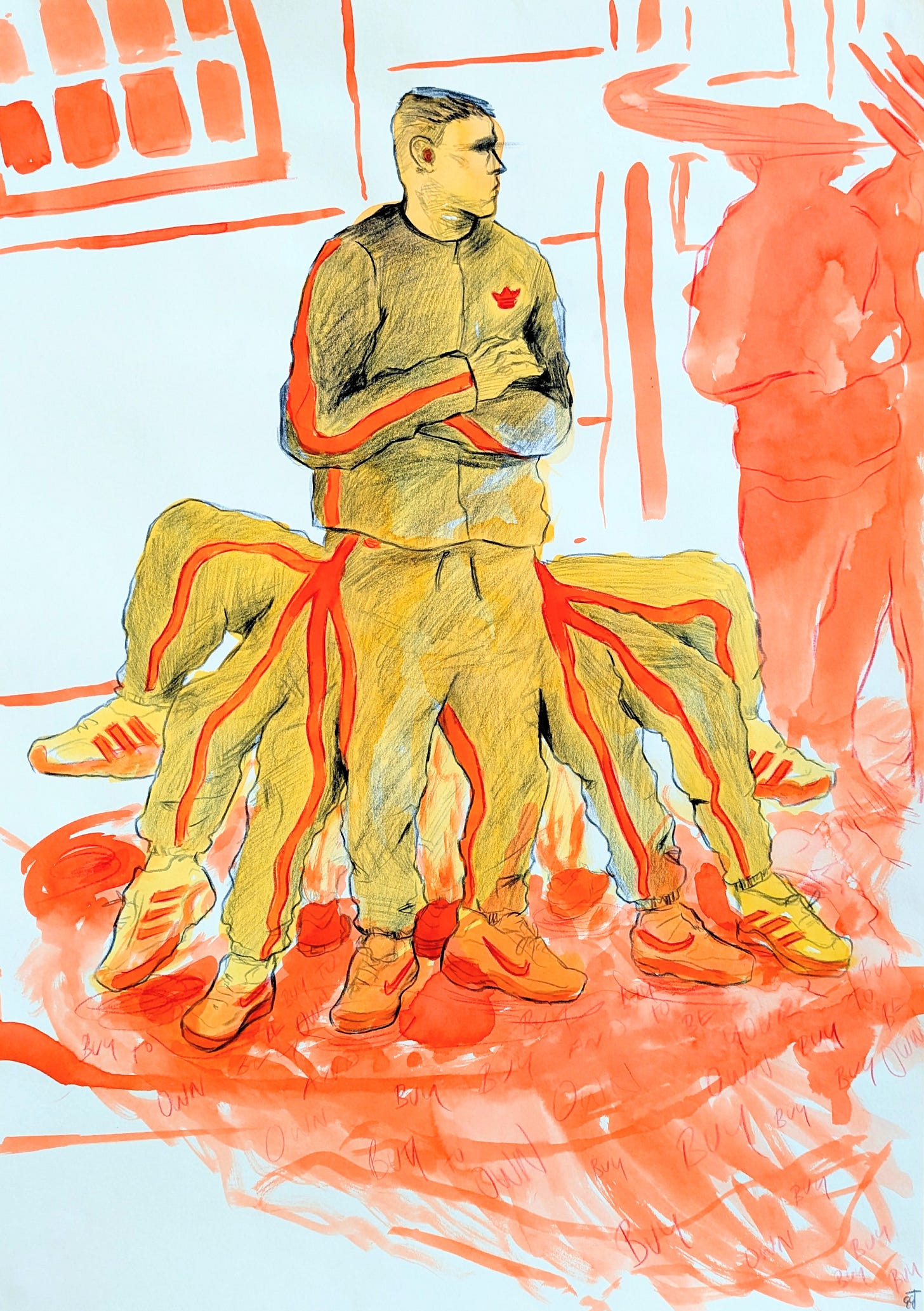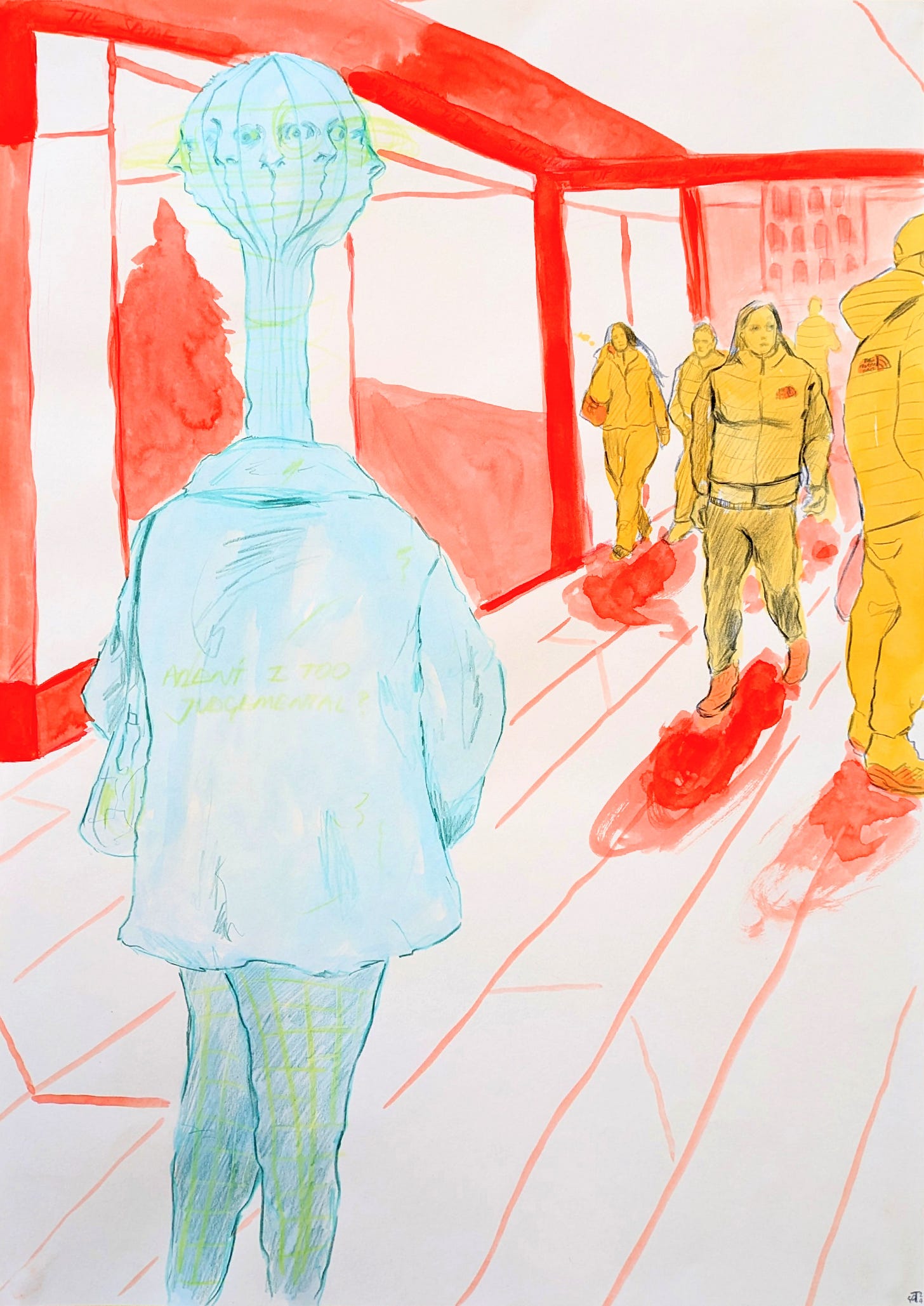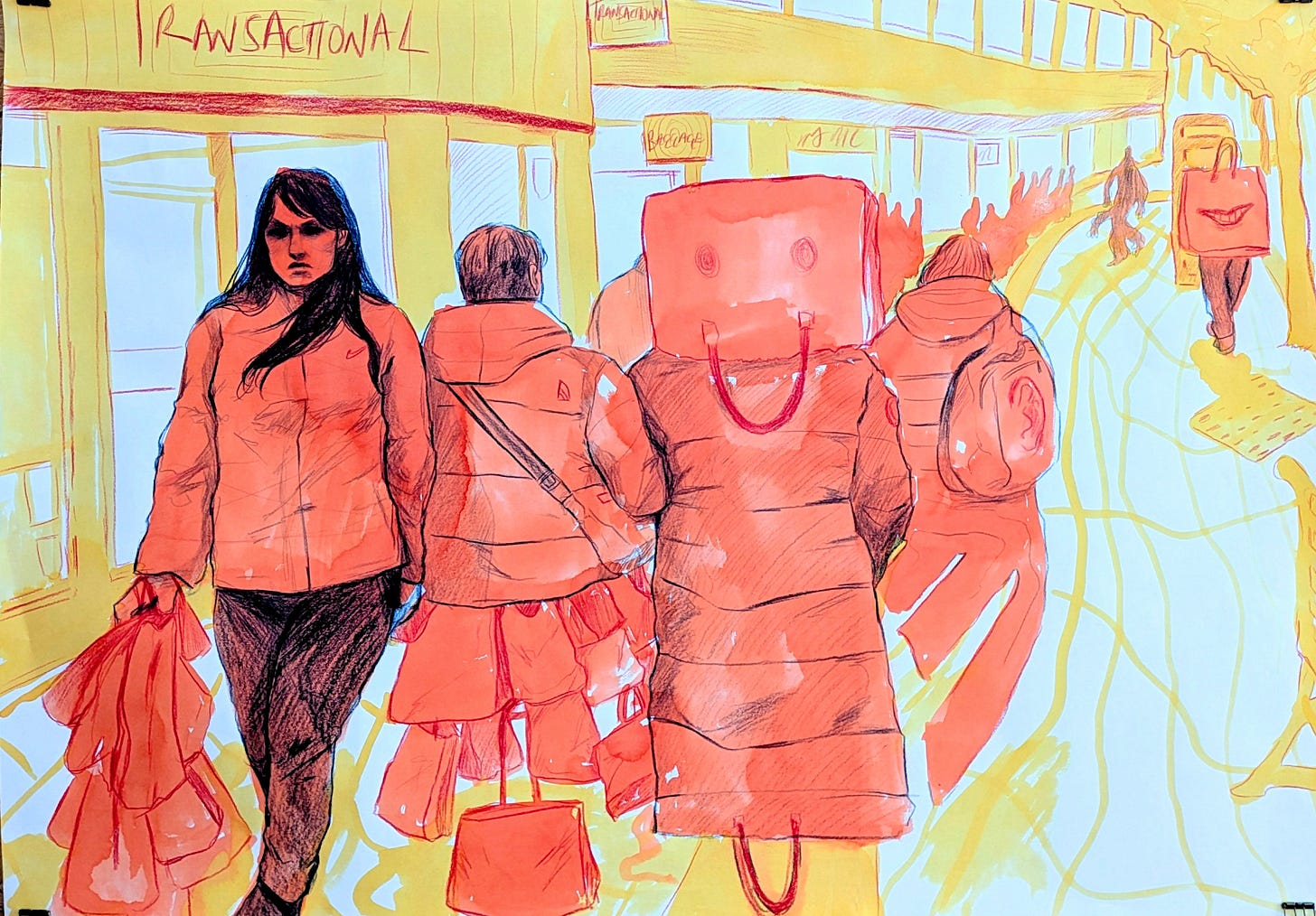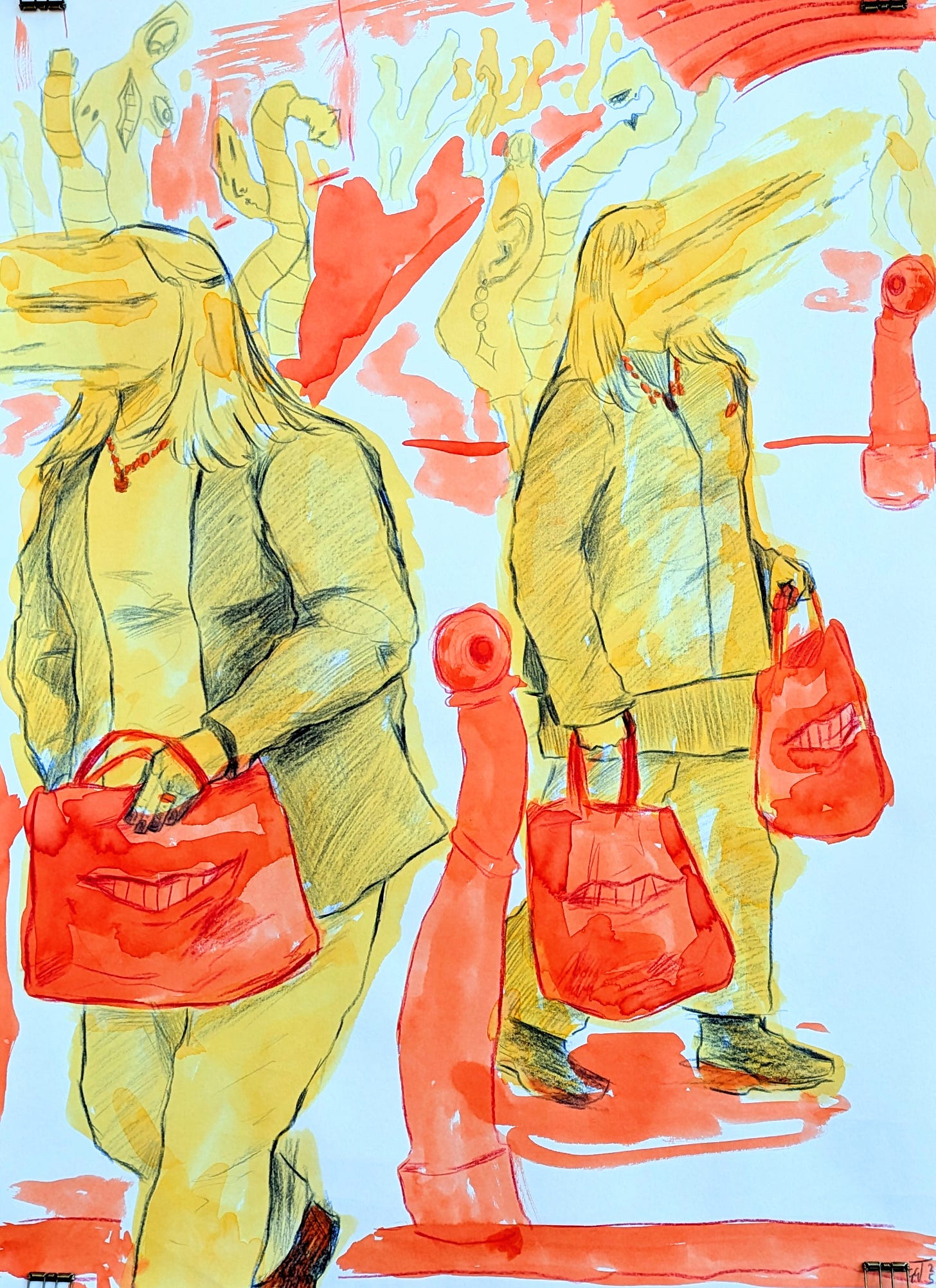Read part 1 here//
Aesthetics and Subculture/
These moment based online niches are better known as AESTHETICS and are the reason for the likely death of subculture. Aesthetics packages itself as subcultures may, with categories matching the style of dress (Think Roadman, Hippie, Goth and etcetera), but the main difference is that Aesthetics uses the visuals of existing Subcultures and eliminates the culture aspect. Communities and movements are reduced to pure commodification, with Aesthetic uniforms being often tied directly to certain brands of which will have to be worn to look right and fit in. I noticed this a lot during my study, with some of the people resembling the old subcultures, but I found that they all wore the same brands in the same way, like it was a UNIFORM with a set of rules to follow- it didn't feel like a cultural movement with creative liberties attached.
Some of these Aesthetics do have the potential to translate into Subcultures though, but with the ‘consume and move on to the new’ approach to social media, there isn't enough physical time for communities to grow roots that will stick. The systematic gatekeeping that also happens on social media doesn't help with this, making newcomers to less mainstream style feel less than welcome unless they fully commit to an aesthetic (again, this often happens when people are wearing the correct brands that match the Aesthetic). Hence, aesthetics just die off as quickly as they were trending.
The fleeting lifespan of aestheticism is designed to directly match the light speed process of commodity production. Brands and social media use their symbiotic relationship to fuel fast fashion culture, ensuring that consumers are locked into the now normalised cycle of: consuming, discarding and then consuming again. According to the documentary ‘Buy now: the shopping conspiracy’, ‘100 billion garments’ are made per year to satiate those ensnared in this flawed system.
Social media is a perfect tool for brands to sheath their poor ethics behind an ever scrolling feedback of shiny distractions, (think hauls, try-ons, giveaways) hypnotising the mass to make them forget any negative feelings they may have towards this system. Therefore, brands are actually profiting from the lack of subculture and individualism. They rely on the masses to follow along as sheep, so that they can maximise profits. A cultural blindness is happening, and I feel that this has to change.
Devil's Advocate/
Maybe I have got all of this completely wrong. Looking back at my initial statement, I feel that there is some truth to it. I do not deny my strong bias, created as a result of my upbringing though, and I feel that this needs to be examined. Maybe, I am alienating those around me because of the way they choose to present themselves, and not the other way around. I admit that there is an arrogance to my views on those around me, and if I change this mindset that has festered, I may see The Mass in a new light. Yes, those I encountered all share similarities, but maybe this is because they are a part of their own community, or possibly their own subculture that I am unaware of. Maybe looking wholly like an individual isn't that important, and that there is merit to blending in a little more, and splashing out on brands that your peers are interested in. This could spark a common interest in those whom would not normally gel together. People can gain joy from believing in a brand, and what it can do for them, and maybe the monetary value isn't really relevant when compared to the way you feel getting dressed up in an ideal.
What is undebatable in my mind though, is the attitude towards those whom do not blend in, and the landfill waste created as a result of the ever changing acceptable aesthetics- all fuelled by the Attention Economy.
How Can You Subvert The Mass Gaze?
So now that you have listened to my views and possibly looked inwards a little at your own opinions, I wanted to present what can be done to counteract a culture that favours wasteful spending and alienation. These are things I am actively trying to combine into my lifestyle and mindset in order to not act as a sheep.
First, try to support local fashion shops. This is difficult due to large chain corporations forcing many small businesses to shut due to competitive pricing. Alternatively try to shop for statement pieces in charity shops, but try to avoid buying ‘new’ stock donated by corporations. Second hand is key to avoid waste, and you will often find pieces with history, and even branded pieces without the price tag. If you buy new, shop for pieces that are both true to your style, and that can be used coordinated with many outfits, to avoid the clothing being left at the back of your wardrobe or thrown into landfill. Regardless of whether you have agreed with any other points I have made, it is clear that we as a society have to stop supporting fast fashion culture, and the wastage it thrives upon.
Second, try to change your attitude. If we slowly change the notion ingrained into us that luxury commodities are the best to surround ourselves with, subcultures could in some manner return. I believe that subculture stands for a collective attitude, and not what exact brand you wear in order to be initiated into an exclusive club. Unlearn the uniform of the Mass, and be unafraid to present yourself in the most authentic way that you possibly can (even if this makes you stand out) and voice your opinion- this may rattle those within the Mass, but eventually like-minded people will join you, growing the roots of a new subculture. Also, more importantly, do not outcast those who dare to be or dress differently. As a society this is something that needs to be changed. Different doesn't equal bad.
Finally, become privy to how branding and social media serves to control you. Many people are aware of marketing tactics, but only on a surface level. The attention economy and in extension social media, use guerilla tactics to catch the consumers eye in any way possible, leading to exploitation for financial gain. Catch this, and don't fall into the traps set. Question everything you see, advertising is hidden everywhere in this age. You could largely avoid this by phasing out social media as much as possible (as I have done), or just ensure to keep yourself educated. Consume and shop content that is ethical and cares about you- and not just about widening wealth divides.
This current economy is all about bombarding you with signs, symbols and slogans to keep you hooked. It is vital to exist outside of this formulaic approach to life, to consume less, educate ourselves more,and to nourish our own individualism. Capitalism actively tries to dull down our inherent creativity (everyone has some) to keep them complacent and buying. We could all benefit from a little change in our lives.
Conclusion/
If you read this far, thank you. If what I have said has interested you, I will leave a list of resources that I used to research this piece so you can educate yourself further. If you think that I have been spouting nonsense, discuss why you think this is- I am aware that my views can be interpreted as pretentious or just plain wrong. This is a big reason that I wanted to do this project, it is a self examination through my warped view of others. The course of this project has surprisingly changed some views of mine and cemented others. Through research I realised that the things I blamed the mass for were actually higher up, systemic issues that would need to change before I, as an individual, would see any difference to the way I am treated.
Writing this, and completing the accompanying artwork made me realise that I need to put my feelings into my practice more. To push back against the things that bother me, even if it is on a miniscule scale.
//////////////
Further Reading:
How to do Nothing: resisting the attention economy (2019) J. Odell
Capitalist Realism: is there no alternative? (2008) M. Fisher
The Subcultures reader (1997) K. Gelder and S. Thornton
Modern European Thinkers: Walter Benjamin Overpowering Conformism (2000) E. Leslie
Consumed, the need for collective change: colonialism, climate change and consumerism (2021) A. Barber
Luxury Fashion Branding: trends, tactics, techniques (2007) J. Okonkwo
Brand Psychology: consumer perceptions, corporate reputations (2015) J. Gabay
‘Teen Subcultures are fading’ (2024) M. Silcoff for the NY Times
McQuails Media and Mass Communication theory (2020) D. McQuail and M. Deuze








There is a clipped version of Hebdige in the Gelder, Chicago School subcultures reader you mention here. Stuart Hall pioneered the Centre in Birmingham in 1964, and it preempted Thatcher’s position and the themes for her emerging policies (not subcultural!). Eventually she shut it down! Have a great day.
You might like to read Subculture: The Meaning of Style by Dick Hebdige, 1979. He is a subcultural theorist who was part of a team of scholars who started to unpick the meaning of subcultures when punk had got a foothold. He was part of the famous Birmingham School of Contemporary and Cultural Studies which brought incredible insight to this fascinating subject. The lens he creates for considering subculture is a form of ‘bricolage’, and he considers aspirational values causing individuals to be incorporated and reincorporated into subcultures. Best wishes.